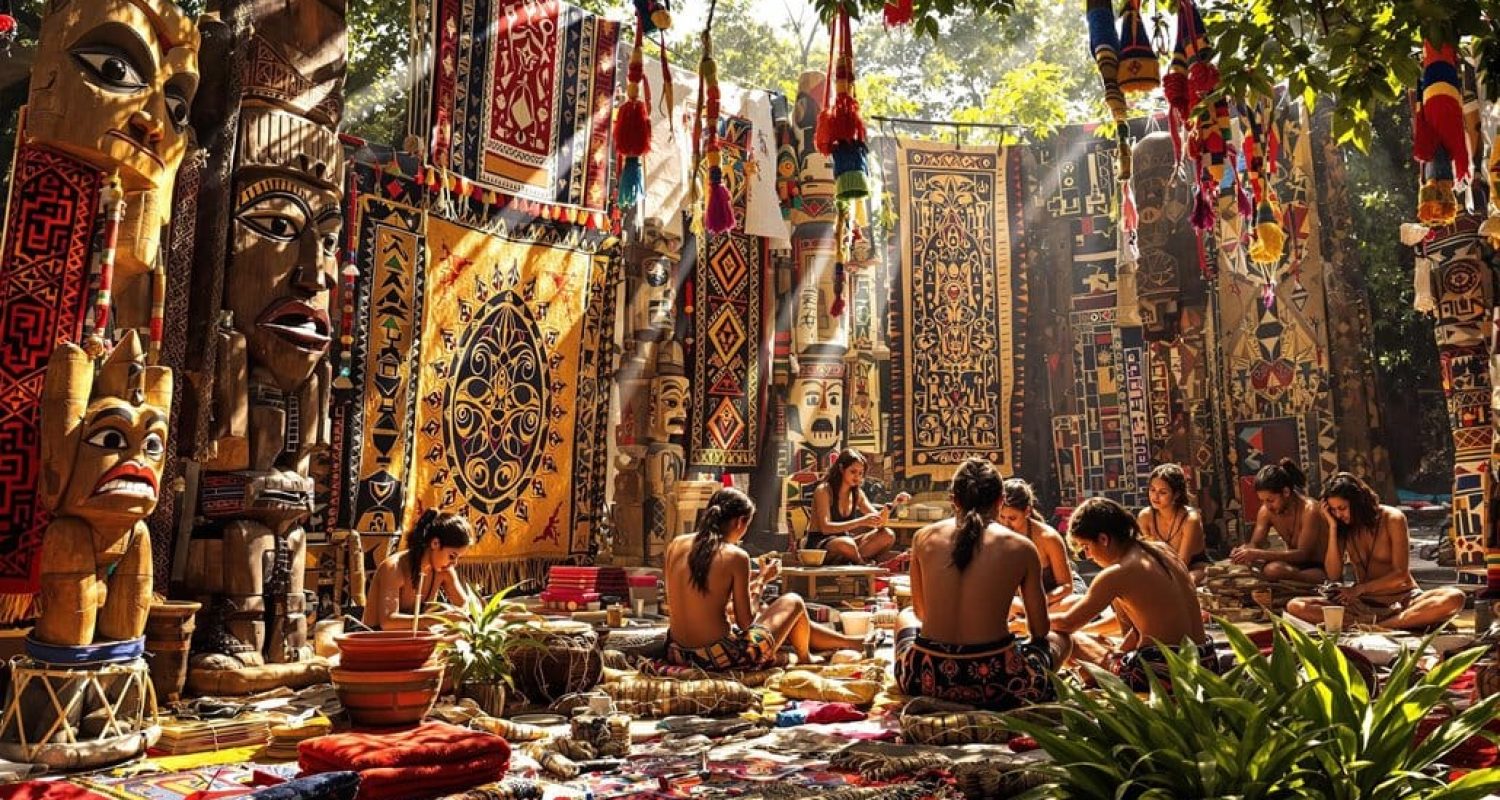Reviving ancestral wisdom through tribal art connects you with the identity and traditions of indigenous communities. Each piece, whether a mask or textile, narrates stories steeped in history and cultural significance. You'll notice how colors and patterns convey deep meanings, while traditional techniques honor the bond with nature. Community workshops foster hands-on learning, reinvigorating old practices and ensuring intergenerational knowledge transfer. As awareness of cultural authenticity grows, contemporary artists adapt these traditions, blending the past with the present. Explore how this artistic movement shapes identities and inspires meaningful connections within communities and beyond.
Key Takeaways
- Tribal art serves as a storytelling medium, preserving ancestral knowledge and cultural identity for future generations.
- Community workshops promote hands-on learning, revitalizing traditional art forms and fostering intergenerational knowledge transfer.
- Ethical practices emphasize sustainable art creation, ensuring the preservation of cultural traditions while supporting indigenous artists economically.
- Cultural immersion experiences enhance understanding and appreciation of indigenous art, strengthening community bonds and cultural identity.
- Technology plays a vital role in documenting and sharing tribal art, ensuring the continuity of ancestral wisdom in modern contexts.
Importance of Tribal Art
Tribal art holds immense importance as a living representation of the cultural identity of indigenous communities. It's not just about aesthetics; each piece tells a story rooted in ancestral practices that connect you to a rich heritage.
When you engage with tribal art, you're participating in a dialogue that spans generations, embodying unique traditions, beliefs, and histories that shape the very essence of a community.
The spiritual significance imbued in tribal art serves as a bridge between past and present. You'll find that traditional techniques—whether through tattooing, weaving, or carving—reflect the wisdom of ancestors passed down through the ages.
This craftsmanship fosters a sense of belonging, as these works are often created collaboratively, strengthening community bonds while celebrating shared values during communal rituals.
In today's world, the resurgence of interest in tribal art empowers indigenous voices, allowing for the reclamation of ancestral wisdom.
Historical Significance of African Art
African art serves as a vibrant tapestry woven from the threads of history, communication, and cultural expression. Its historical significance extends beyond mere aesthetics; it embodies ancestral knowledge and reflects the values and beliefs of various tribes. Masks, sculptures, and textiles serve as essential storytelling tools, capturing the essence of cultural practices and communal identities.
Each piece you encounter isn't just an artwork; it's a representation of social hierarchies and spiritual beliefs, often crafted for specific rituals or ceremonies. These creations connect the community to its identity, emphasizing collective memory over individual expression.
When you admire a beautifully carved mask or intricately designed textile, you're engaging with a lineage that speaks to generations before you.
The impact of colonization and globalization can't be ignored, as these forces have both challenged and enriched African art. While some traditional methods have adapted to contemporary contexts, many artists endeavor to retain cultural authenticity, ensuring that their work continues to convey the rich tapestry of their heritage.
Through this art, you find a sense of belonging, a reminder of the shared history that unites us all.
Techniques and Materials Used
Artistic practices across various cultures showcase a rich array of techniques and materials that reflect unique traditions and values. In ancestral practices like Hawaiian kākau, traditional tattooing employs hand-tapping methods that connect you to the essence of indigenous cultures.
Artists use sharpened albatross bone (mōlī) as tools to apply ink, creating a tactile bond with nature. The ink itself often comes from natural sources like candlenut soot, emphasizing a deep-rooted relationship with the environment.
During these tattooing sessions, skin is stretched taut by assistants, providing a flat canvas for precise and consistent designs. This method not only enhances the artistry but also fosters a sense of community, as everyone plays a role in the process.
The rhythmic application of ink transforms each session into an auditory art form, resonating with ancestral whispers that echo throughout time.
Natural mats, such as lauhala, create a comfortable and respectful atmosphere, ensuring a sacred space for both the artist and the recipient. These techniques and materials not only preserve tradition but also remind you of the profound connections that bind us to our ancestors and their wisdom.
Cultural Symbolism in Tribal Art
Symbols in tribal art serve as a vibrant language, conveying the rich narratives and beliefs of a community. These symbols are more than mere decoration; they encapsulate cultural symbolism that speaks to ancestral practices and the identity of the people.
When you look closely, you see that every color and pattern carries deeper meanings, reflecting values like courage, fertility, and spiritual connection.
Consider these key aspects of cultural symbolism in tribal art:
- Natural motifs: Designs that echo local flora and fauna, illustrating the community's bond with nature.
- Masks and totems: These often embody ancestors and deities, acting as a bridge between the physical and spiritual domains during rituals.
- Communal creation: The act of crafting art reinforces social bonds, ensuring that techniques and meanings are passed down through generations.
Through this lens, tribal art becomes a living narrative, inviting you to connect with the history and wisdom of a community.
It's a beautiful reminder that the stories we tell through art can unify us, honoring those who came before while guiding the future.
Reviving Traditional Practices Today
In today's world, there's a vibrant resurgence of traditional practices that reconnect communities with their heritage, particularly through the art of tattooing. Artists like Keone Nunes are leading this revival, teaching ancestral techniques that breathe life into sacred practices. Traditional Hawaiian tattooing, or kākau, employs hand-tapping methods with tools like mōlī, crafted from sharpened albatross bone. This process emphasizes a profound connection to one's roots, fostering a sense of belonging.
The following table highlights the emotional impact of reviving these practices:
| Ancestral Practices | Modern Connections |
|---|---|
| Hand-tapping techniques | Reclaiming identity |
| Cultural significance | Community resilience |
| Educational initiatives | Passing on traditions |
As interest in ancestral arts flourishes, communities embrace a broader movement toward recognizing and preserving indigenous knowledge systems. This movement not only honors the past but also offers valuable insights into sustainable living. By participating in workshops, such as those at tattoo school Pāuhi in Waianae, you're not just learning a craft; you're also becoming a steward of cultural continuity, ensuring these sacred practices endure for generations to come.
Community Engagement and Education
Throughout history, community engagement has served as the cornerstone for preserving and revitalizing indigenous art forms. By participating in community workshops and educational initiatives, you can play a crucial role in passing down ancestral crafting techniques and storytelling.
These efforts not only guarantee the sustainability of tribal arts but also deepen your understanding of the interconnectedness among different indigenous groups.
Here are a few key aspects of community engagement in this setting:
- Cultural immersion experiences foster appreciation and connection, allowing you to learn directly from local artisans.
- Collaborative programs promote indigenous art through accessible mediums, strengthening community bonds and enriching shared narratives.
- Educational efforts that integrate ancestral wisdom into contemporary practices encourage a sense of pride in cultural identity.
In this supportive environment, you'll find warmth and friendship as you engage with others who share a passion for cultural revival.
Future of Ancestral Art Forms
As you explore the future of ancestral art forms, it becomes clear that a vibrant cultural renaissance is underway. Traditional practices, like Hawaiian kākau, are experiencing a resurgence, reflecting a deep yearning to reclaim identity and heritage. This revival isn't just about aesthetics; it's an essential connection to community and roots.
Educational initiatives, such as Keone Nunes' Pāuhi tattoo school, play a significant role in preserving these ancient techniques, ensuring their continuity in a rapidly changing world. By actively engaging in workshops and gatherings, you can participate in passing down valuable knowledge, fostering collaboration, and reigniting interest in indigenous crafts and storytelling traditions.
Moreover, as you witness the growing global awareness of indigenous rights, there's an increasing demand for authentic ancestral art. This shift promotes cultural authenticity and strengthens communal ties, contrasting sharply with the individualistic expressions often found in contemporary art.
The future of ancestral art forms lies in ethical practices that prioritize the preservation of traditional methods, allowing you to feel not only connected to the past but also empowered to shape the future of your cultural lineage.
Frequently Asked Questions
What Is an Example of Ancestral Wisdom?
An example of ancestral wisdom is the practice of crop rotation, which highlights its cultural significance in sustainable agriculture.
By alternating crops, you're not just enriching the soil, but also honoring traditional practices that have supported communities for generations.
This method reflects a deep understanding of nature's rhythms, fostering biodiversity and resilience.
Embracing such wisdom connects you to your roots, reminding you of the importance of preserving knowledge that sustains both the earth and your community.
Can Anyone Get Kakau?
Getting kākau is like opening a treasure chest of personal heritage.
Anyone can embrace this meaningful tattooing practice, but it's essential to recognize kākau's significance.
The techniques used, from the tools to the application, are steeped in deep cultural connections.
As you explore this journey, you'll find that each design tells a unique story about your ancestry, making the experience not just about ink, but about celebrating who you're and where you come from.
Conclusion
In embracing tribal art, you're not just admiring beautiful creations; you're weaving a vibrant tapestry of history and culture. Each piece whispers stories of ancestors, connecting past and present. By engaging with these traditional practices and supporting community initiatives, you help breathe life into these art forms, ensuring they flourish for generations. As you explore this rich heritage, remember: every stroke and symbol holds the heartbeat of a culture waiting to be revived and celebrated.








